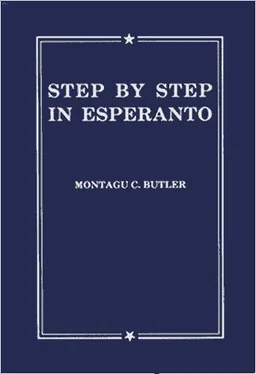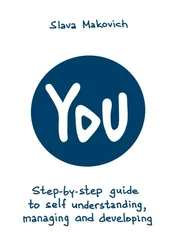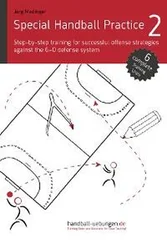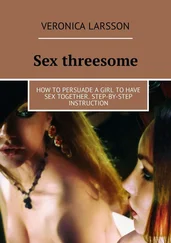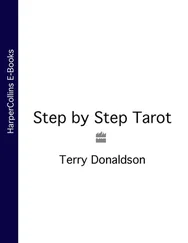aranĝo ĝardeno heĝo oranĝo vilaĝo
74. leĝo, law ; neĝo, snow ; preĝo, prayer ; reĝo, king ; fromaĝo, cheese ; vizaĝo, face .
75. Pronunciation exercise (Legu kaj traduku!) (For each mistake pay a penny fine for some Esperanto cause). Birdo sidas sur la heĝo. Soldatoj( soldiers ) de la regimento. La bildoj sur la paĝo. La vortoj de la preĝo. La leĝoj de la lando. Buter pano( bread and butter ) kaj fromaĝo. Algebro, geometrio,kaj geografio. Dek vilaĝoj estas en danĝero. Sur la tegmento de la kolegio kuŝas neĝo. La generaloestas Germano. Kio estas la aranĝo? Sur la seĝo estas tri kusenoj( cushions ). En la ĝardeno estas naŭ geranioj. En la kaĝo staras tri ĝirafoj. Proverbo: Mono estas reĝo — mono estas leĝo.
76. (a) Kio estasoranĝoj? geranioj? litoj? ĝirafoj? seĝoj? fingroj? la koro? Kie estas lakoro? kapkuseno? kreto? pupitro ? Kio estas lapartoj de la domo (korpo)? mebloj en la ĉambro? Kio estas la signifo en la Angla lingvo de la vortoj soldatino? fratedzino? kuzinedzo? La okuloj, oreloj( ears ), nazo, kaj lipoj estas partoj ….
(b) Birdkaĝo, kaĝbirdo. Finpaĝo, paĝfino. Ĝardenfloro, florĝardeno. Seĝaranĝo. Kapkuseno sur lito. Ĝirafino, Germanino, Germanedzino. Reĝinedzo, reĝedzino.
(c) Rose-garden, garden-rose, hedge-flower, orange-tree, garden-hedge, face-cream, angel-face, music-chair, garden-city, snow-man. Kings and queens. Fields and hedges. Oranges and lemons. Tables and desks.
77. RACE-NAMES. Make sentences with Arabo, Belgo, Brito, Dano, Germano, Greko, Hispano, Italo, Kimro( Welshman ), Norvego, Polo, Rumano, Ruso, Serbo, Skoto, Svedo, Turko. Thus: Li estas Anglo. Ankaŭ ni estas Angloj. Ŝi estas Anglino. In the boat are a Spaniard and an Italian. A Dane is there also. Miss Macpherson is a Scottish lady.
78. Words expressing action or state at the present time (“verbs in the present tense”) end in AS.Compare estas, faras, kuŝas, sidas, staras.
La suno brilas, the sun shines (is-shining).
La bebo dormas, the baby sleeps (is-sleeping, is-asleep).
Ni laboras, we work (are-working).
Ili parolas, They speak (are-speaking, talk).
Tio sufiĉas, That suffices (is-sufficient).
79. Do NOT put estasbefore another word ending with ‑as. Lernas= learns, or, is-learning. Li estas lernas would mean He is learns (he is is-learning)!
The stars are-shining. (The) father is-working. The children are-learning. Miss L. is-speaking. He’s standing. We’re sitting. I’m lying-down. Two eggs are-enough.
80. Li eraras, makes-a-mistake. Mi konsentas, I agree. La birdo kantas.
Similarly: Li atentas (aŭskultas, envenas, legas, pensas, preĝas, rigardas, silentas, skribas, tradukas). (71)
(a) We sit and pay attention, but ( sed) he is asleep. They are-reading and writing (they read and write). I am-thinking and thinking. She is listening and learning. The teacher speaks, but the pupils are-asleep. The girls sit, but the boys stand. I’m telephoning. She looks and listens.
(b) Proverbo: Ni parolas inter kvar okuloj (=inter ni). Sur kiomi skribas? la kato dormas? Por kio (kiu) la patro laboras? Kio brilas en la nokto( night )? …en la tago( day )? Kiu envenas? atentas? parolas?
81. The word NE( =no, not ) denotes the negative. JEShas the same sound and meaning as Yes in English.
Mi ne estas, I am not. Vi ne estas, you are not. Kie ŝi estas? En la domo? Jes, ŝi estas en la domo. Ne, ŝi ne estas ( No, she isn’t ). Ankaŭ li ne (estas), Nor is he. Ambaŭ ne (estas), Neither of them is.
(a) Proverboj. Unu florone estas krono( crown ). Ne por lupo estas supo( soup ).
(b) La floroj ne estas en la vazo. Ne estas lampo tie. Pasero estas birdo, ne floro. The address isn’t in the telephone-book. The cat is in the house, but not the dog. (There) are no snakes ( serpentoj) in Ireland. No, thank you; I’m not an idiot! Yes, they are boots, not shoes.
82. The word ĈU(from the Polish language) means whether. Diru al mi, ĉu li estas tie, Tell me whether he is there . Mi forgesas,( I forget ) ĉu li estas tie, aŭ ne.
83. Questions to which one cannot answer yes or no are asked by a Ki-word ( Kio, Kie, Kiu, Kiom…) and in English, generally, by a Wh -word.
Questions answerable by yes or no are asked in English by altering the word-order (thus: You are becomes Are you? ) or by words like Do (He goes: Does he go?). In Esperanto they are asked by starting with Ĉu … Ĉu li estas tie?= (I want to know or Tell me) whether he is there = Is he there? Answer: Jes, li estas (tie);or Ne, li ne estas (tie), No, he is not. Ĉu vi estas? Are you? Ĉu vi ne estas? Aren’t you?
Li estas tie, Li tie estas, Estas li tie, Estas tie li, Tie estas li, Tie li estas,all mean He is there. Any one of these forms, with Ĉuin front, means Is he there?
84. An unusual order may emphasize a particular word. Thus: Ĉu tie li estas? Is it there that he is?
85. Sometimes, in conversation, ĉuis omitted, the question being implied by the tone of voice. Li estas tie? He is there? But this is not usual.
86. Do NOT use ĉuand a Ki-word together. Ĉu kie li estas? (= Tell me whether where he is? ) is nonsense.
(a) Ĉu la filoj de la filo estas la nepoj? la onklino estas la fratino de la avino? la avo estas la frato de la patro? la patro estas la edzino de la patrino? tomato estas frukto aŭ legomo? pasero estas floro aŭ birdo? la floroj tie estas rozoj aŭ tulipoj? la muro estas en la pordo, aŭ la pordo en la muro? estas libro sur la pupitro, aŭ ne? vi estas edzo aŭ fraŭlo?
87. NEand ĈUare used similarly with other verbs. Ĉu li kantas? Does he sing? Is he singing? Ĉu vi komprenas? Do you understand? Jes, mi komprenas, Yes, I do. Ne, mi ne (komprenas), No, I don’t.
(a) Spegulo ne flatas, a mirror doesn’t flatter . La afero ne urĝas, the matter is not urgent . Demando ne kostas, a question doesn’t cost (anything) . Plumo ne sentas, paperosilentas, the pen does not feel, the paper is silent . Mi ne timas, I’m not afraid .
Читать дальше
